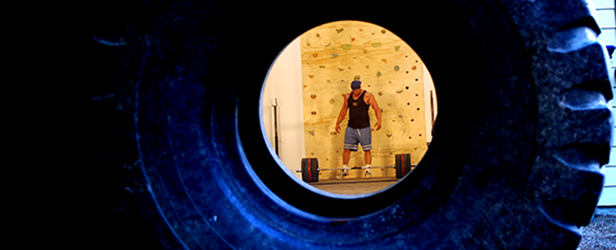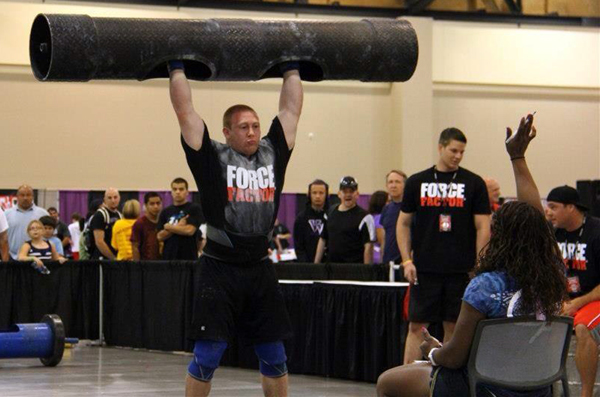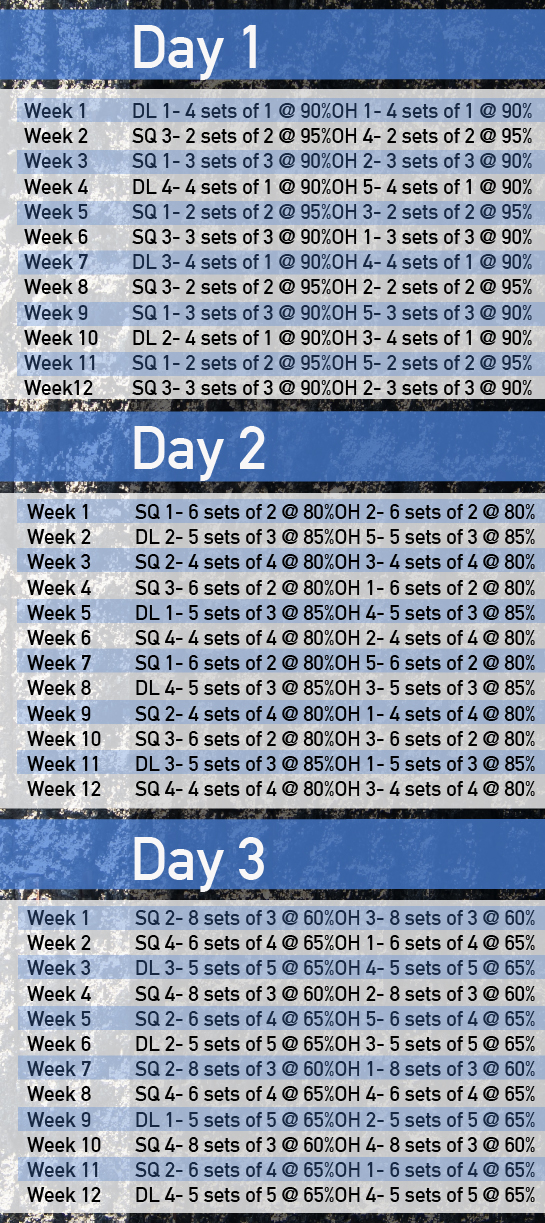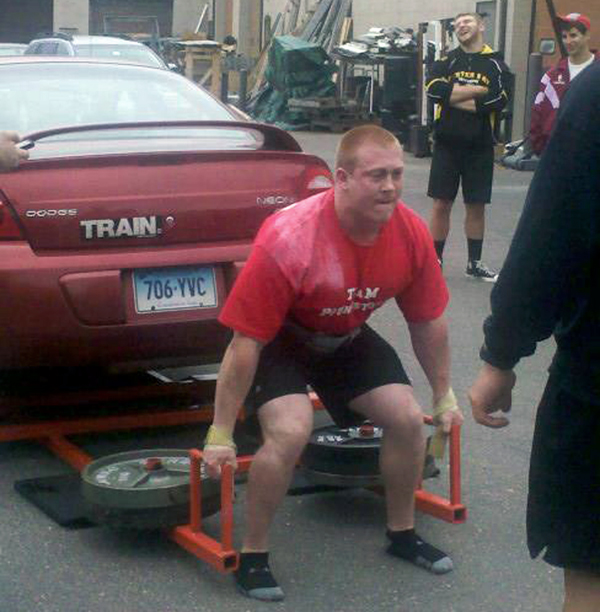
How do you start your off-season training for strongman after a big contest?
I get this question all the time. I think a lot of people will benefit from a basic template to start off-season programming in the right direction. So, that’s what I’m giving you. With this template, you can customize to fit your needs while still holding true to the basic tenants of the template.
When you go into a contest, you are generally trained with high volume and extremely high intensity. By the time the contest is over, you’re beat down from the training cycle and (if you’ve timed your peak right) you have a drop-off in maximal strength. This is expected. The worst thing to do immediately after a contest it to throw in a ton of volume — this only adds to the drop-off. But cutting volume too much can make it even more difficult to get back to your peak strength. It’s a delicate balance. As a compromise, I have found that alternating intensity with high frequency does the best job of maintaining the previous cycle’s gains. This will also build your base for the next contest cycle, and allow you to build your weaknesses.
The first thing to do before developing your off-season program is to choose five different overhead exercises to include. You will soon be pressing three times a week, which is why we choose five exercises. This is different than how the rest of the movement will be setup, because varying the movements and ranges of motion helps your shoulders from getting too beat-up. You can progress through small changes like grip, allowing you to avoid injury.
Overhead Movement 1 (OH1) — Choose the movement that needs the most attention for you (log, axle, DB).
Overhead Movement 2 (OH2) — Choose a variation of the movement that needs the most attention (strict log, strict axle, etc.)
Overhead Movement 3 (OH3) — Choose your best strongman-related movement (log, axle, DB).
Overhead Movement 4 (OH4) — Choose a partial range of movement (board press, floor press, overhead lockouts).
Overhead Movement 5 (OH5) — Choose a strict press assistance movement (seated military press, incline bench press, bench press with a Metal Catapult).
After you’ve picked your five pressing movements, it’s time to move on to squats: choose four squat movements. The majority of people I come across struggle with their front squat, so I almost always suggest using front squat as two of the squat variations. This will give you more exposure to the lift you need the most work with. Front squats also carry over to strongman performance more than any other squat variation — you should not be leaving this exercise out of your off-season program.
Squat Movement 1 (SQ1) — Front Squat
Squat Movement 2 (SQ2) — Use the back squat variation that you gives you the biggest carryover. If the variation you choose pushes your lifts, this can be straight bar back squat, paused back squat, box squat, SS Yoke Squat, etc. The possibilities are endless.
Squat Movement 3 (SQ 3) — If your front squat is a weakness then do front squat again; if your front squat is a strength then do a modification of front squat (paused front squat or front squats to a low box).
Squat Movement 4 (SQ 4) — Overload squat movement. Whatever variation you chose for squat movement two, choose the same but this one will be with bands or chains for overload. The number you will use for calculating your sets will be based on bar weight, the overload will be appropriate for that weight. In other words you, wouldn’t use 200 pounds of chain if you’re squatting 135, but you also wouldn’t use 20 pounds of chain if you’re squatting 400. Elitefts™ coach Mark Watts has published some great stuff on this. If you have any questions on appropriate chain weight or band tension, he is the guy to go to.
Deadlift is the lift that you should train only once per week. The deadlift takes a toll on your central nervous system, so if you plan on doing events after your training, you will need the extra recovery for your lower back. Reducing deadlift frequency gives you this extra recovery.
Deadlift Movement 1 (DL1) — Straight barbell deadlift.
Deadlift Movement 2 (DL2) — This will be a deficit deadlift. I recommend a slight deficit, one to two inches more than what would compromise form and promote injury.
Deadlift Movement 3 (DL3) — If your deadlift is a weakness insert traditional barbell deadlift here; if your deadlift is very strong insert sumo deadlift here.
Deadlift Movement 4 (DL4) — This will be a deadlift overload. I recommend reverse band deadlifts as I like the idea of still being able to work on your form from the same pull position but also benefit from the overload. If you feel that you benefit more from a partial range of motion you can utilize block pulls here. Keep the bar below the knee and, if possible, put the bar right at your weak spot. If you decide on reverse band then calculate your number based on 110 percent of your max. If you decide on the block pulls, then the weight is subjective.
Once you have your lifts chosen it is straightforward plug-and-chug for your main movements each day.
Once you have the main movements planned out, it’s time to start thinking of the accessory work. Accessory exercises will be more individualized; you need to focus on your personal weaknesses. If your upper back is weak, work on that. If your hamstrings are lagging, hit those hard. If you tend to have shoulder pain, work on prehab work such as delt stabilizing exercises or arm work. I find that a lot of shoulder pain is solved by regular, slow eccentric/concentric biceps work.
There are three days for accessories:
Day one is heavy weight/low volume for the main movements. You should follow the main movement up with three to four accessory exercises, doing three sets of six to eight reps for each exercises.
3 sets of 6-8 reps.
Day two is moderate weight/moderate volume for the main movements. Accessory exercises should include two to three exercises for four to five sets of eight to 12 reps.
4-5 sets of 8-12 reps.
Day three is light weight/high volume for the main movements. The focus should be on moving the bar through the concentric portion of the lift (the positive part of the life) as quickly as possible. The accessory exercises on this day should include two to three exercises of three to four sets of 12 to 10 reps. If it’s a barbell accessory exercise, stick with 12 to 15 reps. If it’s a selectorized machine then work with 15 to 20 reps. If you choose to do something with bands such as pull-aparts or triceps pushdowns, you can go as high as 20 to 25 reps.
3-4 sets of 10-25 reps.
As an off-season program, the goal of this training template is to maintain the gains from your last training cycle and to prime the body for the next cycle. It is important to make sure that you address your weaknesses through exercises selection. The variations you choose should prevent you from getting too beat up. If you do end up with too many aches and pains, take a deload right after week six and then complete the cycle.
After you have completed the training cycle once, take new maxes and apply those numbers to your next training cycle. You will then be set-up for a short six-week peaking cycle that will take you into contest form.
Integration of Events
There is a time to give up training the events. That time is after a big contest when you have no immediate plans to compete. Take the first three weeks away from events. After that, you can work them in biweekly on a fourth training day.
Take your worst two or three events (that you know you will see in a contest) and focus on those. You are guaranteed to see the yoke, farmer’s walk, and stone loading (or at least two of the three) at almost every contest.
Once you have your events chosen, just modify how you train them. The first session you can do a moderate distance (40-60 feet) for speed and then increase the weight with the same distance of the next session. Then do a moderate weight with a longer distance. You can change it up many ways.
Remember to always time your sets as a metric for choosing weight and gauging progress. By using a well-thought out off-season program, your event performance should improve dramatically between contests and move you up the ranks in the sport.













1 Comment